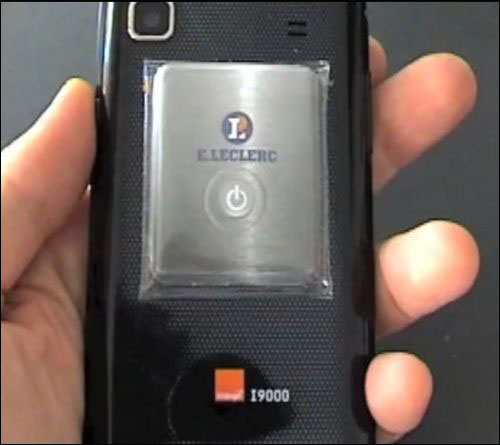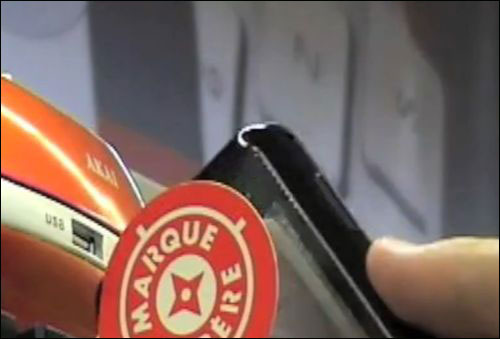Retail chain E. Leclerc is trialing a Near Field Communication (NFC) RFID system at its supermarket in Nice, to determine whether its customers will take advantage of coupons offered on products throughout the store using an NFC-enabled sticker that can be attached to a mobile phone. The system, provided by French NFC firm Think&Go NFC, enables shoppers to download discount coupons by tapping their phone’s sticker against NFC RFID tags attached to store shelves, and to later redeem those coupons by tapping the same sticker against a reader at the point of sale. Once the system proves itself with customers, the store plans to examine a full deployment, while expanding the technology’s uses, such as tracking the movements of patrons throughout the store and determining which areas are typically visited, in what order and for how long.

The technology is designed as a bridge to NFC technology that will eventually be provided on mobile phones. While there have been discussions for years about building NFC readers into cell phones, only a few handsets actually contain the technology. In the meantime, there is a demand for the services that NFC provides, such as electronic coupons that customers can access at their own discretion, using a phone to capture pricing data listed on the store shelf and choosing whether or not they will be able to redeem a coupon. Since there are currently few NFC-enabled phones available to enable this function, Think&Go developed an interim solution. “We have cool technology in front of the users without the phones,” says Vincent Berge, the company’s CEO, who predicts a slow adoption, with approximately 30 percent of phones NFC-enabled by 2013.
For Leclerc, the solution can help move the retailer closer to its goal of switching to paperless coupons by 2020. By employing NFC technology, the retailer can reduce the number of paper coupons that it needs to mail to customers. If the system works effectively and customers indicate that they like it, the store could meet its ultimate goal of eliminating the paper coupons altogether.
The retailer also wants to create a private shopping experience in which each customer has access to discounts and sales that could be of particular interest to that individual, based on his or her previous spending habits. As a result, the Nice store is trialing the NFC system with 200 customers to learn how often they use such a system, and whether the technology increases their spending habits at the store.
During the pilot, which commenced in December 2010 and is expected to continue for about two more months, each participating user receives a MyMax NFC sticker, manufactured by French company Twinlinx. The MyMax, a battery-powered electronic device measuring 45 millimeters (1.8 inches) in length, 36 millimeters (1.4 inches) in width and 2.7 millimeters (0.1 inch) in thickness, includes an NFC reader. The sticker can either be attached to the back of a handset, or merely be carried in a purse, pocket or wallet. The store is also attaching NFC tags to shelves on which promotions are being offered for specific products. When a shopper equipped with the MyMax sticker wishes to receive a promotional coupon for that product, a customer can tap his or her sticker against the tag and press a button on the sticker. The unique ID number on the tag is then stored in the sticker’s memory.
When a customer taps the sticker against a tag, the sticker captures that tag’s unique ID number, which is linked to data about that item, as well as its pricing and promotional offer, in the Think&Go software. Upon arriving at the point of sale, the shopper again taps the sticker—this time, against an NFC RFID reader that downloads the coupon’s ID number and forwards it to the Think&Go software to retrieve details regarding the promotion—and the POS system is then instructed to apply that discount.
“We needed to develop something simple,” Berge states. “Four clicks would be too much.” So instead, the system is designed for just a single button press—a user taps the MyMax sticker or his or her phone against an NFC tag, then presses a button on the sticker itself to either accept or decline an offer.

The Nice store’s managers are utilizing another version of the sticker—the BT Active model, which includes Bluetooth capabilities to allow the NFC sticker to communicate with a mobile phone. As with the shopper’s version of the sticker, workers can attach the sticker to the back of the phone. When managers wish to change a promotion, they can use the mobile phone’s keypad to input details regarding which item’s price is being reduced, and by how much, and then tap the corresponding RFID tag installed on the shelf. In this way, the new price is stored on the tag.
Following the pilot’s conclusion, the store would like to be able to use the data to better understand the behavior of its customers, as well as target promotions to the appropriate customers and offer specials to those who are, for example, VIP shoppers, based on the amount of purchases they make. The stickers would store only a unique ID number to identify a particular patron, however, and no personal details about that individual, thereby protecting his or her privacy. Leclerc’s management has declined to comment for this story.


